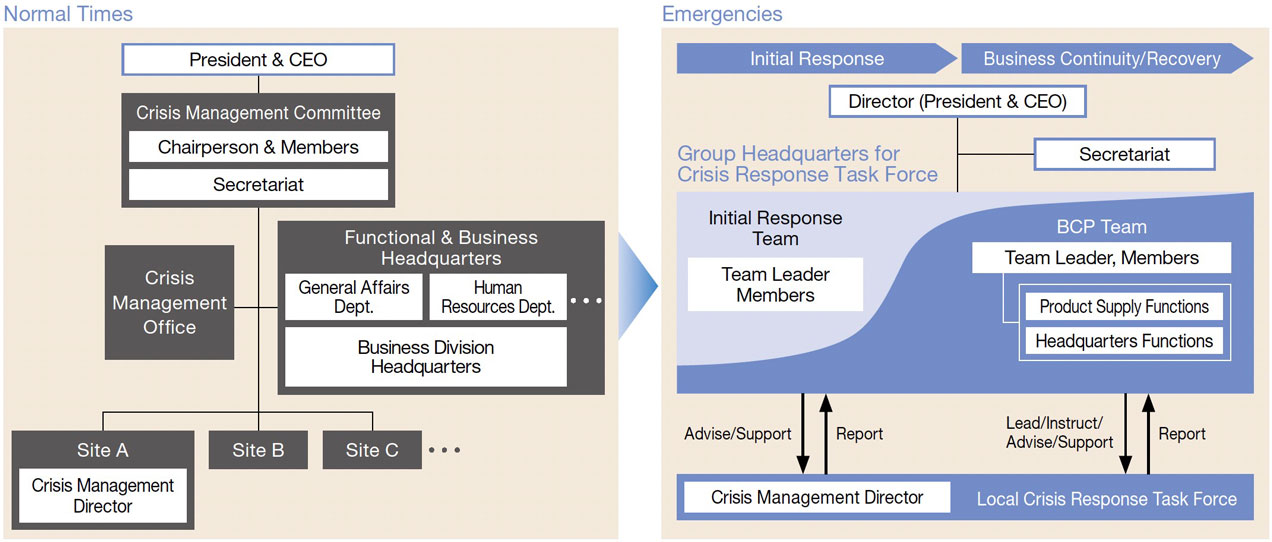
Disaster Risk Management
NSK’s Approach
With a basic policy of placing top priority on securing human safety, NSK’s objective is to protect lives, as people are the foundation of its business, and to resume business activities as soon as possible after an emergency arises. To this end, the NSK Group has established a permanent Crisis Management Committee to oversee Group-wide initiatives to address disaster risk, including natural disasters such as large-scale earthquakes, wind and flood damage, infectious disease outbreaks, and other major incidents. The Committee plans and implements measures to prevent crises and minimize damage in the event that these risks materialize, and is also responsible for establishing and improving business continuity plans (BCP).
System
The Crisis Management Committee is an organization under the direct control of the CEO and includes the heads of functional and business divisions at the head office. During normal times, the committee decides basic policies and principal measures relating to emergency management.
In the event of a crisis, crisis response task forces are set up at the head office as well as at the site of the crisis, and relevant departments cooperate to handle the situation quickly and accurately according to the circumstances. Organizations have also been established in each region outside Japan to supervise crisis management in their respective locations. When a relevant emergency occurs, the Crisis Management Committee in Japan works with the organizations concerned to deal with the crisis.
Crisis Management Structure for Disaster Risks

Click to enlarge

Targets and Performance
Sixth Mid-Term Management Plan Targets (FY2019–2021) and the FY2021 Targets and Performance
| Policy | Sixth Mid-Term Management Plan targets | FY2021 targets | FY2021 performance |
|---|---|---|---|
| Development of group crisis management systems | Strengthen cooperation with regional headquarters outside Japan | Strengthen reporting and information sharing systems |
|
| Optimize crisis management system | Review the management system based on crisis response results | ||
| BCP creation and effectiveness enhancement | Japan: Improve BCP effectiveness for earthquake, wind, and flood damage | Enhance capabilities to continue product supply |
|
| Outside Japan: Establish a BCP against critical risks | Formulate a BCP for critical risks |
|
Mid-Term Management Plan 2026 (MTP2026) Targets (FY2022–2026) and the FY2022 Targets
| Policy | MTP2026 targets | FY2022 targets |
|---|---|---|
| Development of group crisis management systems |
|
|
| BCP formulation and effectiveness enhancement |
|
|
Initiatives
Strengthening Risk Response Capabilities with Business Continuity Planning
Setting Recovery Time Objectives
Recovery time objectives are set so as to enable a resumption of product supply to customers even after a crisis occurs. To ensure recovery within the target period, the NSK Group promptly implements measures to thoroughly minimize damage in the event of a disaster. By reducing the recovery period and securing the minimum inventory required, we will be able to continue supplying products. In anticipation of unforeseen damage and difficulties for recovery within the target period, we are in a state of preparedness so that business activities can be resumed using alternative functions.
Specific Initiatives
At NSK sites, including the head office and Group companies in Japan, we have been preparing for potential emergencies. These efforts include creating emergency organizational structures, establishing response procedures, and assembling useful tools. We also confirm the viability of the preparation through regular drills and address issues that emerge during the drills to make improvements. We are also working to improve BCP effectiveness in the event of a major disaster such as a large-scale earthquake. This is being done by preparing measures to minimize damage, securing emergency communication channels, establishing a reporting system, preparing for large-scale power outages, and ensuring backups for IT infrastructure.
Turning to regions outside Japan, we are formulating BCPs for our business sites based on the assumption of region-specific risks and verifying the effectiveness of the BCPs we have developed in Asia.